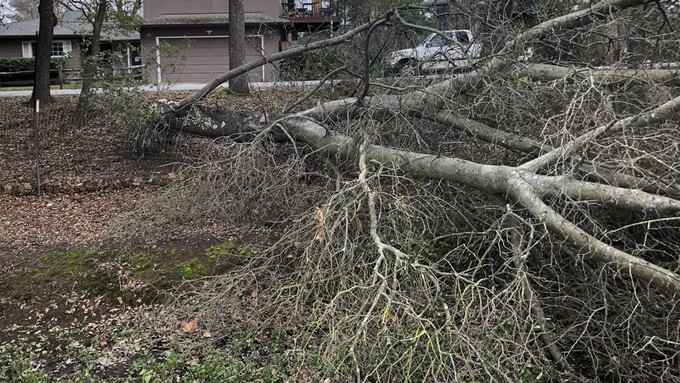
Sacramento could get 4-plus inches of rain, wind gusts up to 50 mph

Trees or branches weakened earlier in winter can fall without warning in a windy storm. Kathy Morrison
“Gusty southerly winds are forecast across interior NorCal Thursday afternoon through Friday afternoon creating difficult driving conditions, downed branches, and possible power outages,” tweeted the NWS Sacramento office on Wednesday. “Secure your outdoor objects and drive with caution in/around high-profile vehicles!”
The weather service also issued two weather alerts: A flood watch from 1 p.m. Thursday through 9 a.m. Sunday and a 24-hour high-wind advisory, starting at 4 p.m. Thursday.
This atmospheric river is tropical in origin; that means more rain than snow in the Sierra. However, that rain could melt snow at lower elevations, adding to flood risk, says the weather service. The flood watch extends from the Sierra foothills to Suisun Bay.
All this wind and rain puts big trees – particularly evergreens – at risk. Some redwoods, cedars and firs are already battered by a very active winter. If another branch is ready to break, this may be the weekend it comes down.
Beware of leaning trees. Their roots may be giving way. Our soil is already moist and soft; that makes it slippery, too. Sacramento received more than a half inch of rain in the series of showers that started March 4. That will seem like a puddle compared to the expected deluge.
The current forecast predicts 4.4 inches of rain between noon Thursday and Tuesday evening. But instead of chilly nights and days in the 40s, our temperatures will be near or above normal. Afternoon highs will hover in the low to mid 60s. The biggest change is overnight lows. Instead of near freezing, nighttime temperatures will stay mostly in the 50s.
Those higher overnight temperatures will help warm soil and speed spring growth. A lot of plants will appreciate all this moisture.
In the meantime, tie down the patio furniture. Clear gutters and storm drains of any debris. Move potted plants (especially succulents) to sheltered locations. All that rain can rot succulents as well as seedlings.
For more weather updates: https://www.weather.gov/sto/#.
Comments
0 comments have been posted.Sacramento Digs Gardening to your inbox.
Sites We Like
Garden Checklist for week of July 21
Your garden needs you!
* Keep your vegetable garden watered, mulched and weeded. Water before 8 a.m. to reduce the chance of fungal infection and to conserve moisture.
* Feed vegetable plants bone meal, rock phosphate or other fertilizers high in phosphate to stimulate more blooms and fruiting. (But wait until daily high temperatures drop out of the 100s.)
* Don’t let tomatoes wilt or dry out completely. Give tomatoes a deep watering two to three times a week.
* Harvest vegetables promptly to encourage plants to produce more. Squash especially tends to grow rapidly in hot weather. Keep an eye on zucchini.
* Pinch back chrysanthemums for bushy plants and more flowers in September.
* Remove spent flowers from roses, daylilies and other bloomers as they finish flowering.
* Pinch off blooms from basil so the plant will grow more leaves.
* Cut back lavender after flowering to promote a second bloom.
* It's not too late to add a splash of color. Plant petunias, snapdragons, zinnias and marigolds.
* From seed, plant corn, pumpkins, radishes, winter squash and sunflowers.